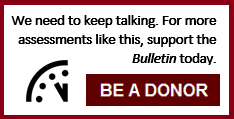Can nuclear talks overcome Arak?
By Ariane Tabatabai | September 23, 2014

Amid the thorny nuclear negotiations between Iran and six world powers, most observers have recognized two main sticking points: How much to limit Tehran’s ability to enrich uranium, and how sanctions will be lifted. But as meetings resume between Iran and its negotiating partners—the United States, the United Kingdom, France, Russia, China, and Germany, also known as the P5+1— an issue once thought settled is anything but.
The Arak Heavy Water Reactor, also known as IR-40, almost derailed the initial rounds of talks in 2013. Following the conclusion of the interim deal in November of that year, French Foreign Minister Laurent Fabius expressed his concerns over the reactor, telling the French newspaper Le Monde (link in French) that “Arak, the most proliferation-prone facility, the one producing the most plutonium, is not necessary for civilian use. But once it goes online, we cannot destroy it.” ( A few months later, though, reports seemed to indicate that debate over Arak had been more or less settled, with a former US State Department official saying that differences were narrowing, and a former Iranian negotiator calling the issue “almost solved.”)
Since then, there have been conflicting reports about the reactor’s future. In early 2014, Ali Akbar Salehi, the head of the Atomic Energy Organization of Iran, said that his country could “do some design change.” This design change would allow the reactor to “produce less plutonium,” he said, which would “allay the worries and mitigate the concerns.” Many have debated what this design change would entail. It would have to meet two goals: effectively reducing the proliferation risk posed by the reactor to reassure the international community that it will not produce weapons-grade plutonium, and allowing the Iranian negotiating team to reach an acceptable solution over the reactor, one that it can sell at home. Such a solution would allow the reactor to operate for the peaceful purposes Tehran says it is pursuing.
The Arak facility is a 40-megawatt heavy water thermal reactor. It is fueled by natural uranium and uses heavy water as a moderator. Tehran started planning for the reactor back in the 1980s, but construction did not begin until 2004. The plant was scheduled to become operational later this year, but the Joint Plan of Action reached in November 2013 suspended work on it for six months. Tehran’s aim for the reactor is to replace the old 5-megawatt thermal Tehran Research Reactor, which was provided to Iran by the United States as part of the Atoms for Peace program under the Shah, the ruler overthrown by the Islamic Revolution in 1979.
The West views the reactor as “optimized” for plutonium production. This is a proliferation concern, as plutonium could be used in a nuclear weapon. The basis for the West’s argument is that Arak is fueled with natural uranium (a type superior for plutonium production), and that once operational, it would run at a power level (40 megawatts) deemed “unnecessary” by Western experts. The completed reactor would be able to hold around 50 kilograms of weapons-usable plutonium (enough for about six nuclear weapons, based on the International Atomic Energy Agency’s estimate that a nuclear weapon would require 8 kilograms of plutonium). Another concern, as noted by Fabius, is that the reactor would become virtually indestructible once it became operational. As former Israeli chief of military intelligence Amos Yaldim said, “Whoever considers attacking an active reactor is willing to invite another Chernobyl, and no one wants to do that."
According to Tehran, Arak is a research reactor. Its official aim is to test materials, produce radioisotopes for industrial, agricultural, and medical use (for example, for cancer treatment), and test fuels—including fuels for future use at the Bushehr power plant, which is currently supplied by Russia under a deal that will end in 2021. In 2003, Tehran told the IAEA that it planned to have Arak use natural uranium. At the time when these plans were being made, Tehran didn’t know whether its enrichment program would be successful and sustained and was not sure whether it would be able to purchase the enriched uranium needed for Arak. Iran also contends that it has no plans to develop reprocessing capability. Without the ability to reprocess, the country would not be able to separate the plutonium from irradiated fuel. This would mean that Arak’s plutonium couldn’t be used in nuclear weapons.
The two sides have also debated converting the heavy water reactor into a light water reactor, which would reduce the risk of proliferation. In the West, this possibility is viewed as the optimum solution to the Arak problem.
On September 19, though, Iranian Foreign Minister and chief nuclear negotiator Javad Zarif told me that such a conversion would not be an option. Instead, he said, his country would be willing to modify the reactor to effectively address proliferation concerns. This modification would reduce plutonium production to 1 (or maximum 2) kilograms per year. “Light water reactor is not a technology we have,” he said. “We would have to rely on others for it and we can’t rely on others.”
The issue of self-reliance is at the very core of the Iranian assessment of its practical needs. It is a key component of Tehran’s revolutionary narrative. Since the establishment of the Islamic Republic, Iranian officials, led by Supreme Leader Ruhollah Khomeini and now his successor Ali Khamenei, have stated that their country must be self-reliant—in all areas, but especially with regard to technology, whether for military or civilian uses. This issue has become an even more dominant part of Tehran’s narrative in the last decade as the country has faced more sanctions and refusals from abroad to supply goods.
The nuclear program is naturally an important area where Tehran wants to become self-reliant. This is certainly driven by pride and revolutionary ideals, but also by concerns stemming from the country’s experience of being denied fuel and technology in the past. For Iran, converting Arak into a light water reactor and then depending on outside help to operate it would give foreign powers a bargaining chip that they could use to manipulate the country.
Tehran’s political and economic isolation of the past decade make it difficult for Iranians to accept the idea that they should simply give up the ability to sustain a nuclear program without outside help. This means that a deal perceived as making Iranians dependent on others for their nuclear energy would not be one the negotiating team could sell at home. The foreign minister’s words resonate with many Iranians across the political spectrum. They view their country’s dependence on others, and Russia in particular, as a challenge that must be overcome. Months ago, I spoke to a former journalist in Tehran about the Iran-Russia nuclear cooperation deal, which currently includes supplying Bushehr and could lead to more contracts in the next few years to build another seven or eight reactors. “We can’t rely on the Russians,” she said. “It’s really important that the world knows this.”
Together, we make the world safer.
The Bulletin elevates expert voices above the noise. But as an independent nonprofit organization, our operations depend on the support of readers like you. Help us continue to deliver quality journalism that holds leaders accountable. Your support of our work at any level is important. In return, we promise our coverage will be understandable, influential, vigilant, solution-oriented, and fair-minded. Together we can make a difference.
Topics: Columnists, Nuclear Energy, Nuclear Weapons














